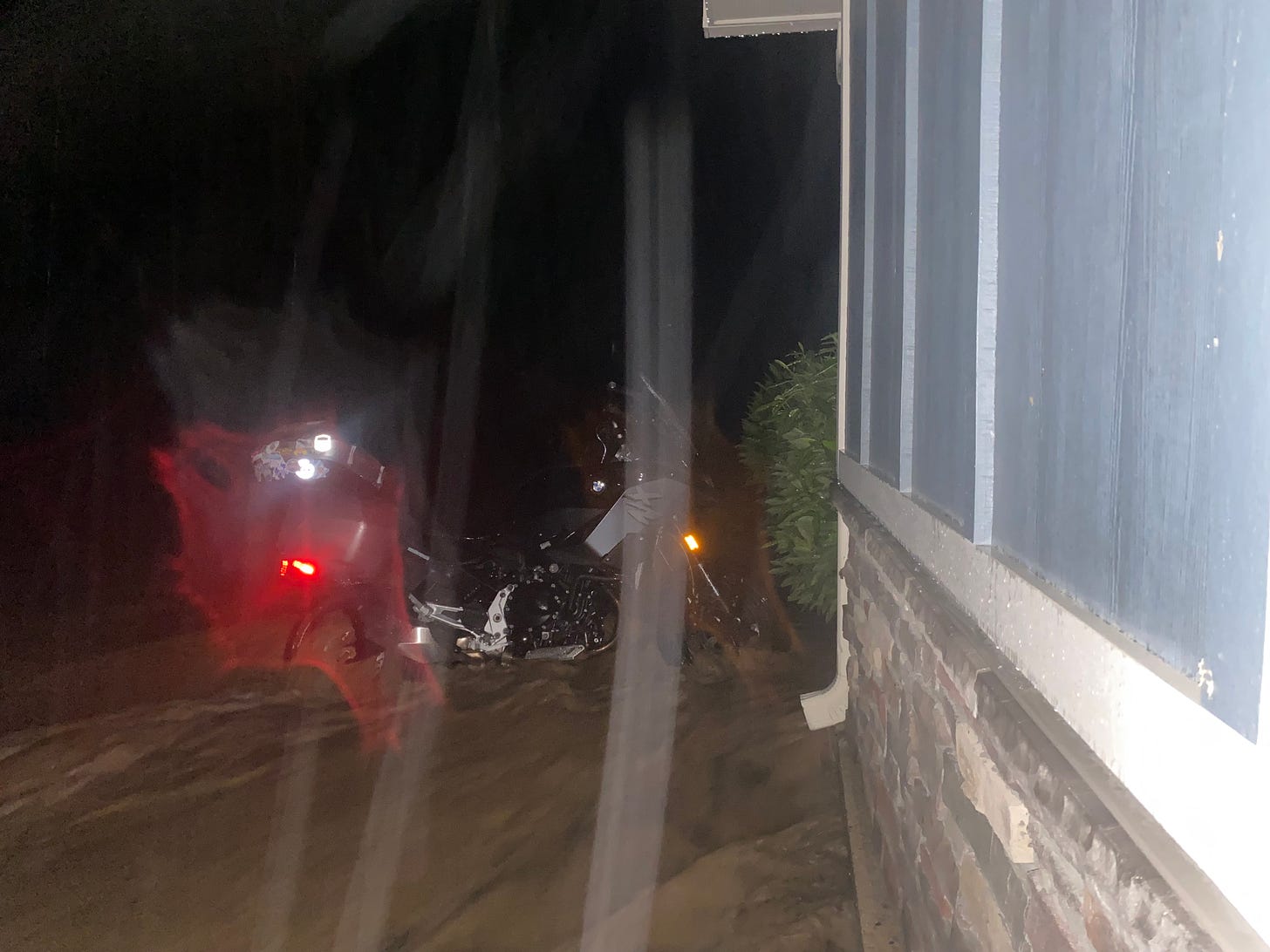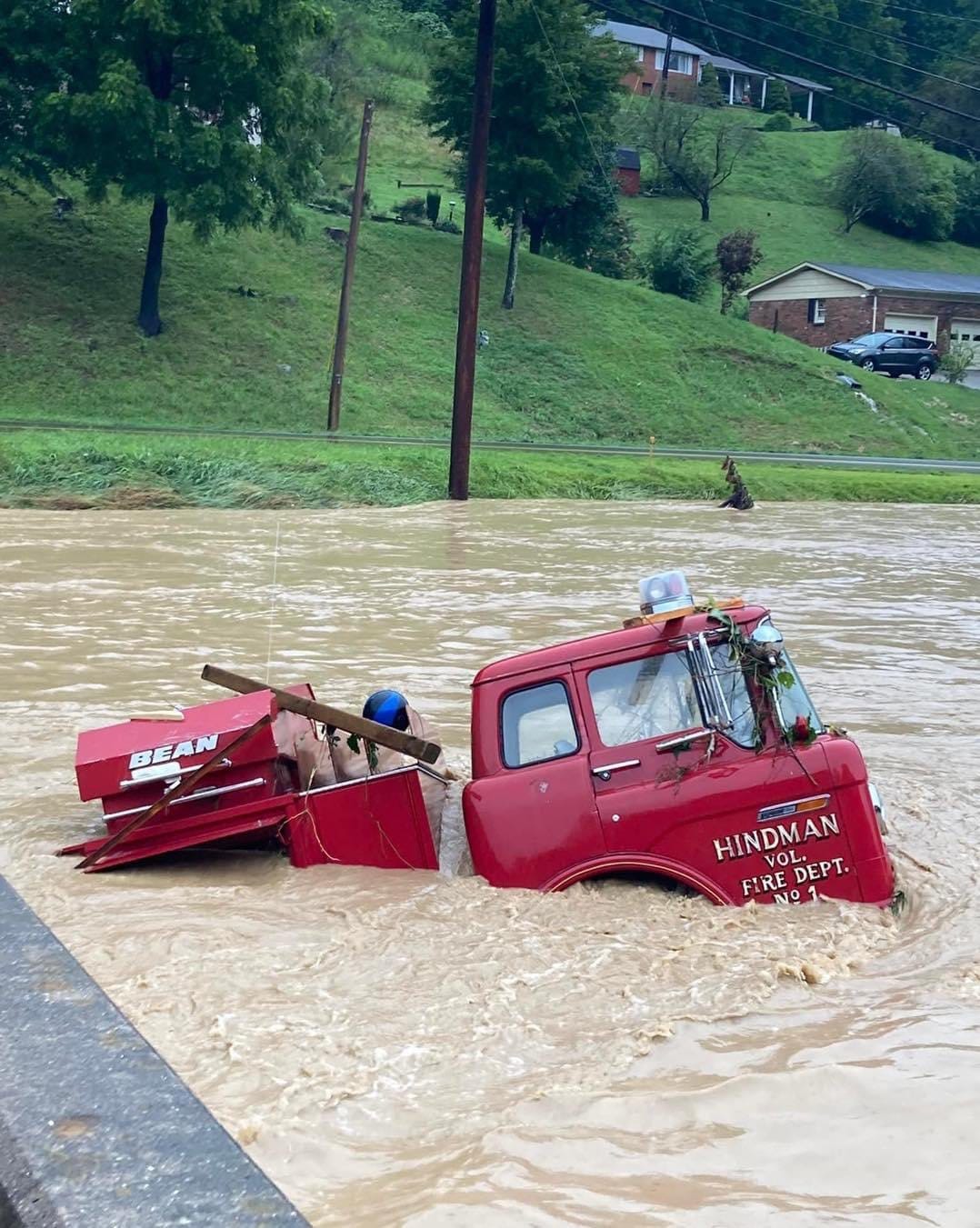The Dog Ate My Newsletter
And my motorcycle
Tamela, get up! Tamela!” A flashlight blinds me.
“Josh?” I sit up. What’s the director of the Appalachian Writers Workshop doing in my room at 2:30 in the morning?
“What’s wrong?”
“Your bike might already be washed away. You might save it if you leave now.”
Save my bike? My brand-new bike!
For three days in late July, 2022, our mobile phones had buzzed with severe thunderstorm and flood warnings in southeastern Kentucky. The aptly named Troublesome Creek, which runs alongside the campus of Hindman Settlement School, had risen daily as we writers trekked from our dorms high on the mountainside to the classrooms below, where we studied poetry and perfected our prose. We even joked about preventing the rain by carrying umbrellas.
The daily deluge had petered out hours earlier while we were in our evening program. Nevertheless, Josh had reminded us during end-of-day announcements to move our vehicles away from Troublesome in light of forecasted overnight rain. When I described where I had parked my three-month-old BMW F 900 XR, Josh confirmed that the creek had never risen to that height. Satisfied, I trudged up the mountainside to my dorm and turned in without a care in the world.
Josh’s flashlight disappears and I hear him knock on the door across the hall. God’s bowling alley thunders overhead as a burst of wind rattles the windows. I jump out of bed. How can this be happening? I turn on the phone’s flashlight to find my clothes, key, and helmet.
My fellow dorm-mates poke their heads out of their doors as I dash into the hallway and head for the front door. The emergency lighting casts eerie shadows on their worried faces. “Be safe,” they whisper.
Now I’m headed down the mountain. Fast-moving water runs three inches deep along the only paved path from dorm to holler. My Gore-Tex boots will keep me dry if the water stays below my calves. Seventy-some steps later, I’m at the Gathering Place building when I realize that runoff from the dorm’s path has met the rising tide of Troublesome Creek, and I’ll be swept away in chest-high water if I proceed. I turn and sprint to the high end of the building where there’s a set of stairs to the parking lot below. I hope Josh is already there. He said he would come down to help me.
Gripping the stair rail with my left hand, I shine my phone light to prevent a misstep as I descend. Relieved when I reach the sidewalk that runs along the back side of the Gathering Place, I strain to see my brand-new bike. It has to be there. It’s only another 100 yards away.
I shout into the dark void, “Josh?” No answer; with the thunderstorm and rushing water, he probably can’t hear me until we’re side by side.
From the base of the stairs I rush down the sloping sidewalk as water creeps over the curb. In a couple dozen steps, it laps at the foundation of the building. “Josh? You here?”
I press on as the water continues to rise. As I near my bike I see that the sidewalk is underwater. My light reflects off the stickers on my top case when I get within six feet. Whew, it’s still here.
Josh is nowhere to be seen. I hope he’s safe. Safe, and on his way. Can I really afford to wait for help? I might have to move it by myself. That’s when I remember the handlebars are locked. I can at least unlock them while I wait for Josh…but, I’ll have to step into the water.
I point my light downward to gauge the water’s height. It’s over the curb and well up the bike’s frame. My stomach falls. I hesitate. I can’t just let my new bike drown! If I’m gonna do something, I gotta do it now! The water is only going up!
Tentatively, I leave my right foot on the sidewalk and step down into the water with my left. It gushes over the top of my boot, cold and fast. Phone outstretched, I lean toward the bike, lifting my right foot off the sidewalk to get closer and assess how I can maneuver to the far side to unlock the handlebars. My gut tells me not to take another step.
I tilt my head toward the angry heavens. “Is anyone out here? Can you hear me?” My brand new bike is six feet away and I’m too weak to save it. Why didn’t I make sure I had help before coming down here? I take a picture of the bike then step back onto the sidewalk, ashamed of my hesitation and the opportunity it cost me.
Don’t give up. I’ve got to keep trying. I pull up Josh’s phone number. Voicemail. Try again. Voicemail. Into the night I shout once more, “Help! Is anyone here?”
I redial; Josh answers. “Josh, where are you?” Lots of static. “Josh?” Out of the corner of my eye, a flash. It’s lightning reflecting off the windshield of my bike as it floats toward me and bumps up against Nancy’s blue Subaru. How did it rise that fast?
The bike bobs against the Subaru’s rear quarter panel. Even if it comes up beside me like a pony, I can’t ride it out. Too much water rising too fast. Crestfallen, I save myself instead.
The next morning, everyone is packing up. There is no potable water, no electricity, and anyone who can’t help with the cleanup needs to get out of the way. I am not the only one who lost a vehicle in the flood, but it’s common knowledge that a motorcycle is special. Friends try to assuage my sadness with reminders that a bike can be replaced while I can’t. Of course they’re right.
One of the workshop faculty lives relatively close to my home in North Carolina and I accept a ride. We make small talk as we are rerouted around washed-out roads and closed gas stations. Instead of crying, I numb out when I see people still stranded on rooftops, neighborhoods under water, and the hundred deadly beautiful mountain waterfalls that let loose where the soil liquified. My mind jumps ahead and pictures the coming months, when everything dries out and hundreds of rock slides will devastate residents once again.
Nearly three weeks after getting home I told a friend about my tendency to stare for hours and how much more I’d been sleeping. She said I should look up PTSD—I might have similar symptoms. Turns out I did (and still do), especially survivor’s guilt. Now Hurricane Ian has devastated Florida and parts of South Carolina.
The dog didn’t really eat my newsletter as the headline stated—the flood delayed it. With my new flood survivor’s perspective, I’m working on a couple of pieces about the Ohio River flood of 1937. That flood took 385 lives, left one million people homeless, and accrued $500 million in property damage.
Stay tuned.





This is so timely for me in so many ways, Tamela. I still remember waking up right after you came back into Stuckey and discovering not long after that my own car was a lost cause. I am writing about my family in Hurricane Agnes and the flood of 72 in northern Appalachia (the Southern Tier of NYS, to be specific), which is now leading me to unearth stuff about a previous flood in 1935 (and another in 1916, and another in the 1890s...) . I also really resonate with your descriptions of residual trauma and survivor's guilt. This stuff is real. Thank you for putting words on it.
It is interesting how guilt creeps it’s way into our lives during times of tragedy. Valerie and I just returned from trying to secure and clean up our little “Coastal Cottage” in Englewood, Florida. Our little beach town was hit extremely hard and our neighborhood was absolutely decimated. Our winter home is likely beyond repair. Roof gone, carport and laundry room a pile of rubble, the lanai blown to pieces, significant water damage with concerns for rapid mold growth. We are the third generation to own and enjoy this home. My grandparents were the original owners, then my parents, then us as we bought it from mom and dad in 2015. Valerie spent three years lovingly renovating it. But it is a winter home not our primary home that we love and enjoy in Indiana. We have several wonderful Florida neighbors/friends who are “Full Timers”, not “Snow Birds” like us. It is all they have. It was both disheartening and demoralizing to drive into the neighborhood each day this week. But we get to drive away, they don’t. That is where the guilt creeps in.
Tom and Valerie Davis